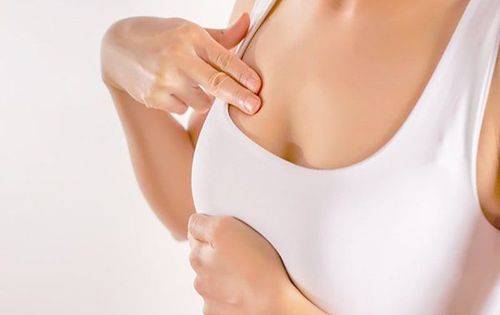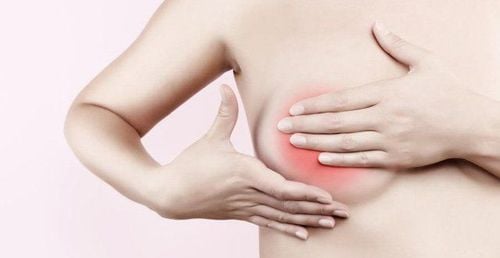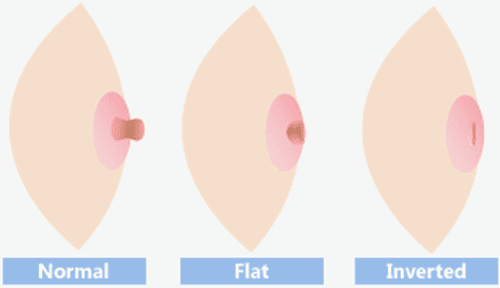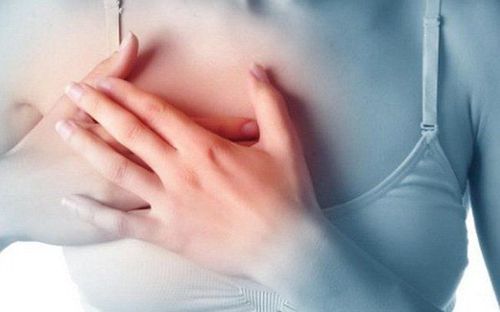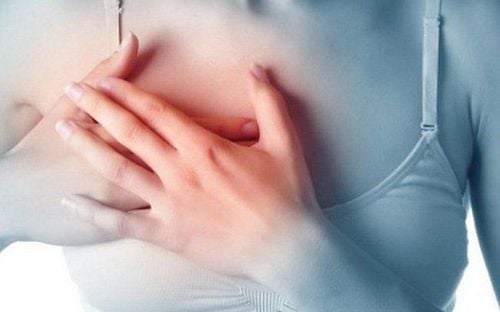This is an automatically translated article.
Benign diseases that can be encountered in the mammary gland include: cystic fibrosis of the mammary gland, breast fibroadenoma, chlorophyll, mammary cyst, mastitis and breast abscess... When there are signs of suspicion, people Patients need to go to the doctor early to identify specific breast diseases, in order to have the right intervention measures, and proactively prevent possible bad complications.
Benign breast diseases include:
1. Cystic Fibrosis of the Breast
Concept
Women with cystic fibrosis usually start after the age of 30, usually between the ages of 40 and 50, and the pathological symptoms may disappear after menopause. Cystic fibrosis of the breast may or may not have clinical manifestations. This is a diffuse lesion consisting of many coordinated abnormalities including major factors such as:
Milk ducts proliferate and cyst formation. Cysts are caused by parts of the milk ducts being more or less dilated and secreting seroma. The segments of glandular proliferation are also called segmental hyperplasia and sclerosing glandular hyperplasia, fibrous stroma. Proliferative lesions including epithelial cell proliferation, sclerosing gland proliferation, and papilloma increase the risk of breast cancer. Clinically, the clinical signs manifest as cyclical breast pain, usually appearing about 8 days before menstruation and disappearing after menstruation, the pain occurs spontaneously, spreading to the arms.
Physical signs: the characteristic cysts are round, well-defined, slightly hard, often painful, commonly located in the upper outer quarter, and variable in size and number. Hard plaques can be encountered, clinically, hard patches on the breast are often seen with unknown limits, the most common location is the upper outer quarter and disappears after menstruation. Breasts can increase in volume.
In terms of subclinical, X-ray film shows increased density of the breast, with fuzzy contrast images corresponding to edematous areas, round contrast images corresponding to cysts; There are large and small calcifications scattered, not concentrated in groups. Ultrasound can help differentiate between cysts and hard lesions. Aspiration makes cytological examination of the cysts allowing to evaluate the color of the fluid, when aspiration shows blood mixed with cystic cancer, it must be thought of as cystic cancer; However, if the fluid is clear, cloudy, yellow or green, this is usually a benign cyst. After cyst aspiration, it is necessary to re-examine the breast to ensure that the tumor has been completely removed; If the tumor remains, a biopsy should be performed for cytology.
Treatment of cystic fibrosis of the breast
Treatment with drugs is the main thing. In addition, non-steroidal anti-inflammatory drugs can be used; surgical removal of the cyst in the cases of probing showed blood containing fluid, papillae in the cyst, cytological examination showed doubtful results; Simple drainage of painful cysts can be performed. Histopathological biopsy techniques are performed in cases where solid plaques are present after cyst drainage or after 2 menstrual cycles and cancer may be suspected if dysplastic cells are present on biopsy.

Điều trị xơ nang tuyến vú bằng các thuốc là chủ yếu
2. Fibroids of the breast
Concept
Fibrocystic breast cancer occurs when the tumor grows from the connective tissue between the lobules, has a capsule, can be found in one or both breasts and usually occurs before the age of 35. The tumor is firm, regular , round or ovoid, subcutaneous, painless, unrelated to menstrual cycle; Size varies about 2 - 3cm; Usually there is only one tumor, sometimes there are multiple tumors and appear successively over time.
Treatment
Definitive diagnosis is made by ultrasonography and fine-needle aspiration cytology to rule out malignancy. Treatment should be carried out before the age of 35 and followed up every 6 months; Surgery when the tumor is large and rapidly growing; After the age of 35, the tumor needs to be surgically removed and histopathological examination is done to confirm.
3. U chlorophyll
Concept
Lymphoma forms from the epithelial muscle around the lobules, the stroma grows quickly, is easy to recur, in about 20% of cases it is a malignant tumor.
Clinical examination shows that there are often many tumors in both breasts, the tumor is solid and firm, round, mobile, changing the shape of the breast, there are many proliferative veins on the breast surface.
Treatment
Regarding treatment, because benign syphilis tumor has a high risk of local recurrence, it is necessary to widen the tumor locally without damaging the tumor, do not pair the tumor with forceps, and do not have a biopsy. core because it can cause local recurrence, if there are many recurrences, mastectomy should be done. If the postoperative diagnosis is malignant chlorophyll, extensive resection of adjacent tissue is required at the following surgery.
4. Breast cyst
Breast cysts are common in women around 35 to 50 years old, very rare in young women under 25 years old. Breast cysts are usually discrete, mobile, dense masses. Aspiration of the cyst shows a lemon yellow or brown color, if the aspirated fluid is blood, a biopsy must be performed after aspiration to test to exclude the possibility of cancer. After aspiration, if the cyst recurs, it must be aspirated again and surgically removed.
5. Fatty tissue necrosis
Fatty tissue necrosis is common after trauma or damage due to biopsy, there may be hard tumors, nipple retraction; Biopsy is required to rule out breast cancer. Treatment is by injection to remove the necrotic mass, possibly in combination with hormonal drugs.
6. Diseases with nipple discharge
Disease of nipple discharge outside of breastfeeding period can be caused by: dilatation or cystic ductal fibrosis; increased lactation associated with amenorrhea, infertility; ductal papilloma, breast cancer. Clinical examination should note the color of the discharge with the characteristics of clear, bloody, or other color associated with the tumor, with many rays or rays, continuous or intermittent discharge, spontaneous or squeezed, fluid whether it is related to menstruation, taking oral contraceptives or taking estrogen. The treatment is intervened depending on each case of injury.
7. Inflammation of the mammary gland
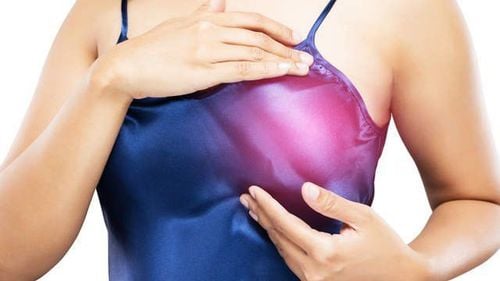
Viêm tuyến vú là bệnh hay xảy ra ở phụ nữ mang thai và cho con bú
Mastitis is a common disease in pregnant and lactating women, especially women who have given birth for the first time, who have not had experience with breastfeeding and do not know how to clean their nipples. The cause of the disease is usually caused by bacteria on the skin such as streptococcus, staphylococcus entering the breast tissue through scratches or blocked milk ducts that are not treated properly.
When the mammary gland is inflamed, the breast has symptoms of swelling and pain, the milk is irregular, not clear, the skin color is slightly red or not red, there are small lumps, accompanied by fever, fear of cold, headache, body and chest pain ie, thin white or yellowish tongue moss. When it comes to the stage of pus production, the breast is swollen, the skin is red hot in groups or the whole breast, pain increases, high fever and local pus burning, people feel uncomfortable, thirsty mouth wants to drink water, red tongue substance, tongue moss yellow.
8. Breast abscess
Breast abscess is an inflammation deep in the mammary gland when the inflamed mammary gland is not detected, diagnosed, and treated promptly and properly. From the infection of the nipple, bacteria will enter the mammary duct causing mastitis; if diagnosed and treated early, inflammation can be reduced and completely cured; If treated late, where the infection will create an abscess, the treatment will be more difficult. Usually breast abscess is common in people after giving birth and breastfeeding, but rarely in pregnancy, except in cases of scratch or damage to the nipple. When there are symptoms of mastitis or breast abscess, it is necessary to go to the doctor for a definitive diagnosis and active treatment, to avoid affecting the health of the mother and the fetus.
Breast tumors, although benign, have a significant impact on women's psychology and quality of life. In case the tumor is large, causing pain, discomfort and aesthetic impact, women can go to Vinmec International General Hospital for treatment to remove benign breast tumors by biopsy technique with the support of suction equipment. vacuum under ultrasound guidance (VABB). With this method, instead of having to open surgery to remove the tumor as before, the doctor only needs to insert the needle of the VABB machine to cut the tumor and suck the tumor out. The patient will experience less pain and no scarring. Especially, it does not cause breast deformity, does not require hospitalization. The patient does not need to undergo many incisions to remove the tumor, but only one needle is needed to treat the tumors, even treat many tumors at the same time.
Please dial HOTLINE for more information or register for an appointment HERE. Download MyVinmec app to make appointments faster and to manage your bookings easily.




